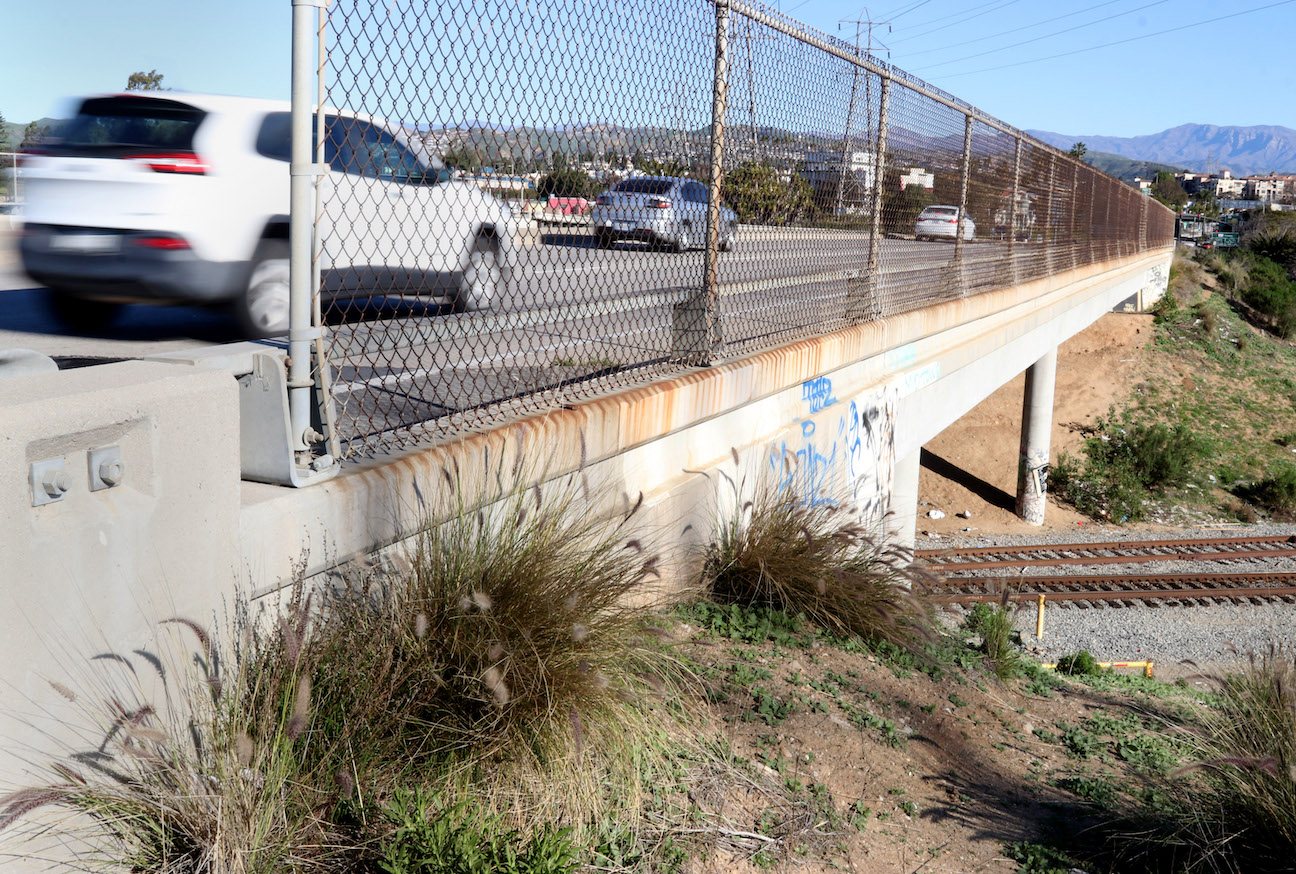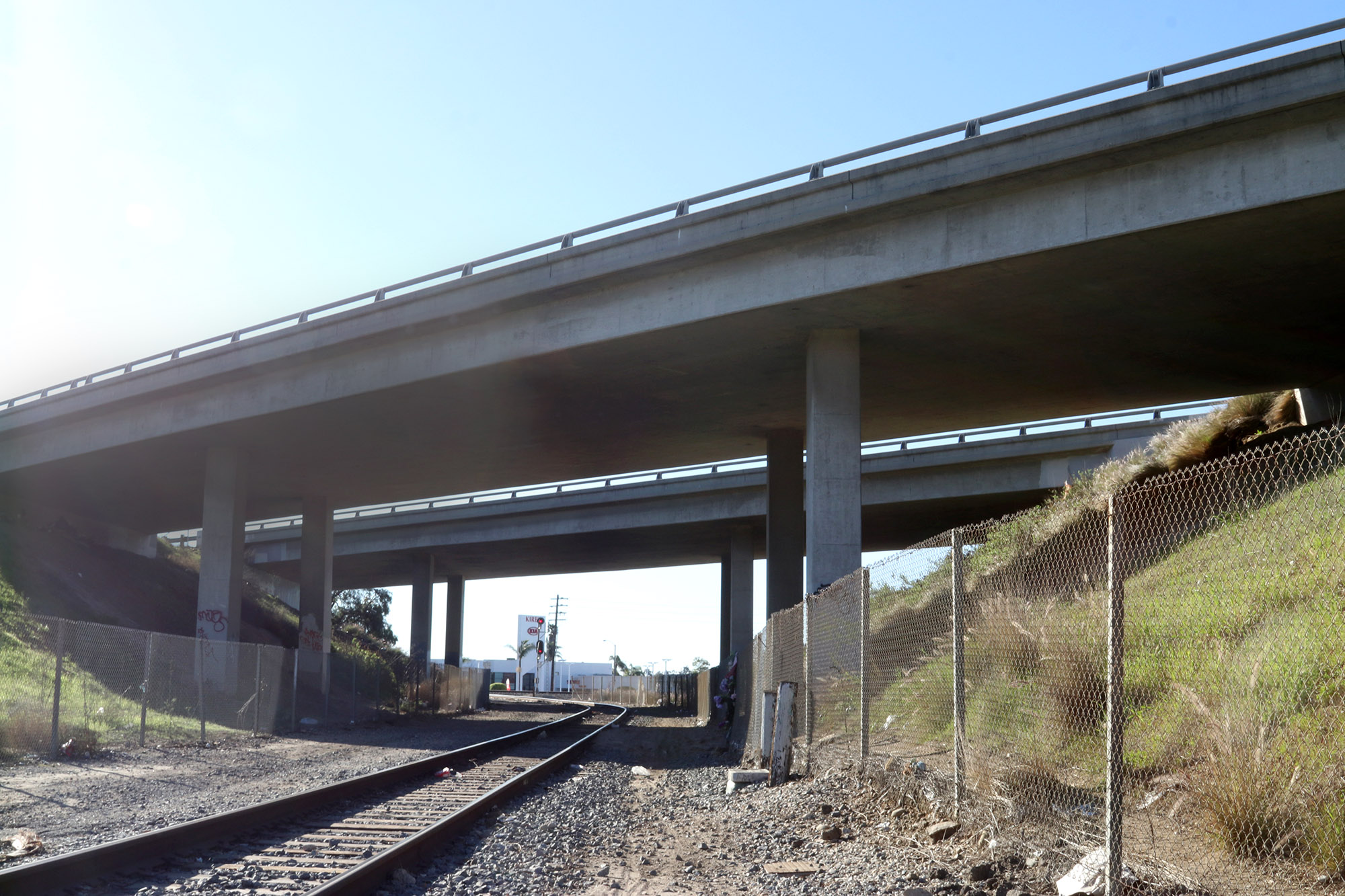Federal, state authorities flag 71 bridges in tri-county region as ‘poor’
IN THIS ARTICLE
- Central Coast Topic
- pacbiztimes Author
By pacbiztimes Thursday, February 10th, 2022

Each day, an estimated 72,500 vehicles cross a bridge on the southbound lanes of Highway 101 over railroad tracks at the Montalvo Metrolink station in Ventura.
In Santa Barbara County, bridges on the northbound and southbound lanes of Highway 101 over San Jose Creek, west of Highway 217 in Goleta, carry about 60,500 vehicles every day.
And in northern San Luis Obispo County, a Highway 101 bridge in Templeton takes about 31,000 vehicles every day over Las Tablas Road.
All of these bridges are considered to be in “poor” condition by the Federal Highway Administration, making them some of the highest-trafficked bridges in the tri-county region with a “poor” rating.
According to FHA data, there are at least 71 bridges in the region in poor condition, including some along Highway 101 and major arterial roads that see tens of thousands of vehicles each day. Santa Barbara County has 30 bridges in poor condition, San Luis Obispo County has 24 and Ventura County has 17.
There are 1,309 total bridges across the tri-counties in the FHA’s database; 53% are rated in “good” condition and 41% in “fair” shape. The federal database uses bridge records included in the 2020 National Bridge Inventory, a collection of bridge element data submitted to the FHA by states and federal agencies.
The bridge that collapsed Jan. 28 in Pittsburgh, Pennsylvania was rated “poor” by the FHA. However, a “poor” rating does not mean a bridge is “necessarily unsafe to drive on,” said John Waddell, a deputy director of the San Luis Obispo County Public Works Department.
Bridges found to be in “poor” condition need “a significant amount of work” and have “appropriate restrictions,” such as weight limitations, Waddell said.
“There’s signage or traffic control to reduce risk, so you don’t have a large city bus driving over a bridge and it collapses like in Pennsylvania,” he said.
Bridges in “fair” condition are showing some wear and might need maintenance work in the future, Waddell said, but many don’t have any repairs currently recommended.
San Luis Obispo County has plans to replace several bridges rated “poor” and perform significant repair work to get others out of the “poor” category, but it’s a multi-year process, Waddell said.
California has more than 26,000 bridges, according to Caltrans spokesman Will Arnold. Caltrans is responsible for the maintenance of more than half, and the rest are maintained by local agencies, such as counties and cities.
Caltrans inspects every bridge in California at least every two years and rates them as “good,” “fair” or “poor” based on issues like cracks, concrete loss and the need for repainting.
Bridges are prioritized for maintenance based on their condition, Arnold said in an email to the Business Times. A “poor” rating — while not an indication that the bridge is unsound — signals maintenance of the bridge should be prioritized.
California will receive nearly $850 million in federal funds in fiscal year 2022 and $4.2 billion over five years to fix the state’s bridges, Arnold said. The priority will be the more than 1,500 bridges rated in “poor” condition in the state, he said.
“This is the largest federal bridge formula program in American history and is made possible by the passage of the bipartisan infrastructure law,” Arnold said. “This historic investment will help fix the state’s bridges that need it most, make them more resilient and safer for all users, and keep our economy moving.”
Chris Kurgan, director of roads and transportation at the Ventura County Public Works Agency, said the Central Coast region’s temperate Mediterranean climate is “much easier” on roads and bridge systems compared with other California areas or other states.
“We’re probably better off than most counties and most locations because we live in a temperate climate,” while dramatic temperature swings create “much higher wear and tear” on bridges, Kurgan said.
Ventura County recently completed an electronic bridge management system, with information about every bridge including location, upgrades, renovations and photographs, and is working on sharing the system with other California counties, Kurgan said.
Ventura County will “look to leverage any opportunities for federal funding or state funding to continue to improve bridges and fix those bridges we know need to get repaired,” he said.
Statewide, Caltrans repairs an average of 221 bridges per year. That number increased by about 85% with the passage of the Road Repair and Accountability Act of 2017, which provides about $5 billion a year in transportation funding, split between the state and local agencies, through 2027.
By 2027, Caltrans will have repaired 500 more bridges than it would have without that funding, Arnold said.
The Pittsburgh bridge collapse put the spotlight on the condition of the country’s bridges, just weeks after President Joe Biden signed a trillion-dollar infrastructure bill that includes $27.5 billion for bridge repair over the next five years.
U.S. Rep. Salud Carbajal, D-Santa Barbara, said in a Feb. 2 news release that the law is “the largest investment our nation has ever made to repair our bridges, which will help Central Coast residents get to school and work, create good-paying jobs, connect communities and drive commerce.”

HIGHEST-TRAFFIC BRIDGES IN ‘POOR’ CONDITION IN EACH COUNTY
San Luis Obispo County
• Templeton: Highway 101 at Las Tablas Road: 31,000 vehicles per day
• Paso Robles: Highway 101 over Union Pacific railroad tracks near Spring Street: 30,500 vehicles per day
• Paso Robles: Niblick Road over Highway 101: 30,055 vehicles per day
Santa Barbara County
• Goleta: Highway 101 over San Jose Creek, west of Highway 217: 60,500 vehicles per day
• Goleta: Highway 101 over Maria Ygnacio Creek, east of Patterson Ave.: 60,500 vehicles per day
• Santa Barbara: Highway 101 over Castillo Street: 54,000 vehicles per day
Ventura County
• Ventura: Highway 101 over railroad tracks at Montalvo Metrolink station: 72,500 vehicles per day
• Ventura: Victoria Avenue over Union Pacific railroad tracks: 43,600 vehicles per day
• Camarillo: Highway 101 over Pleasant Valley Road: 36,545 vehicles per day
Complete, searchable data is available at the Federal Highway Administration website.










